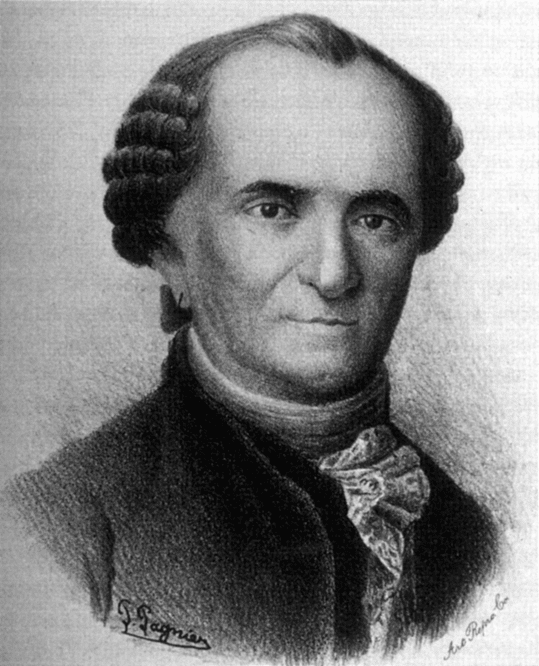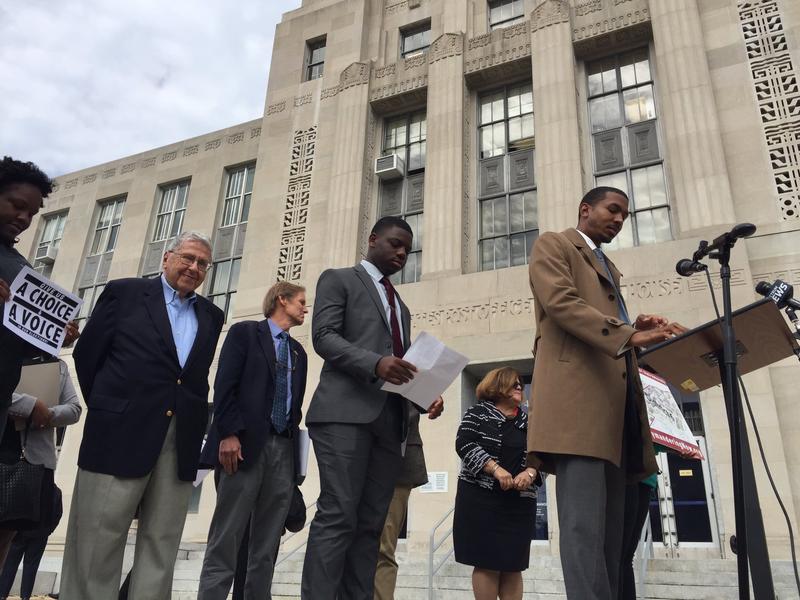- Publisher |
- Science Friday,
- WNYC
- Media Type |
- audio
- Podknife tags |
- Science & Medicine
- Categories Via RSS |
- History,
- Science,
- Society & Culture
- People |
- Country Of Origin |
- USA
- Produced In |
- New York, NY
- Premiere Date |
- 2017-05-02
- Frequency |
- Periodic
- Explicit |
- No
This podcast currently has no reviews.
Submit ReviewHello Undiscovered fans! We're here to tell you about a new show we've been working on at Science Friday. Science Diction is a podcast about words—and the science stories behind them.
Hosted by SciFri producer and self-proclaimed word nerd Johanna Mayer, each episode of Science Diction digs into the origin of a single word or phrase, and, with the help of historians, authors, etymologists, and scientists, reveals a surprising science connection. Here's a sneak peek!
These days, biologists believe all living things come from other living things. But for a long time, people believed that life would, from time to time, spontaneously pop into existence more often—and not just that one time at the base of the evolutionary tree. Even the likes of Aristotle believed in the “spontaneous generation” of life, until Louis Pasteur debunked the theory—or so the story goes.
In a famous set of experiments, Pasteur showed that when you take a broth, boil it to kill all the microscopic organisms floating inside, and don’t let any dust get in, it stays dead. No life will spontaneously emerge.
His experiments have been considered a win for science—but according to historian James Strick, they might have actually been a win for religion.
This episode originally aired on Science Friday, when Elah joined Ira Flatow and science historian, James Strick, to find out what scientists of Pasteur’s day really thought of his experiment, the role the Catholic church played in shutting down “spontaneous generation,” and why even Darwin did his best to dodge the topic.
FOOTNOTES
Though Darwin was bold enough to go public with his theory of evolution, he seemed to shy away from the spontaneous generation debate. But his theory inevitably invited the question: if life could spontaneously arise once on Earth, why not many times? James Strick writes about and-the-origin-of-life-public-versus-private-science.pdf">Darwin’s complicated relationship with spontaneous generation.
The basic premise of Louis Pasteur’s famous swan-necked flask experiment is shown below. The swan necks let life-nourishing air into the flask, but kept potentially contaminating dust out.

GUEST
James Strick, associate professor at Franklin and Marshall College
CREDITS
This episode of Undiscovered was produced by Elah Feder and Alexa Lim. Our theme music is by I Am Robot And Proud.
In 1880, scientist Albert Michelson set out to build a device to measure something every 19th century physicist knew just had to be there. The “luminiferous ether” was invisible and pervaded all of space. It helped explain how light traveled, and how electromagnetic waves waved. Ether theory even underpinned Maxwell’s famous equations! One problem: When Alfred Michaelson ran his machine, the ether wasn’t there.
Science historian David Kaiser walks Annie and Science Friday host Ira Flatow through Michaelson’s famous experiment, and explains how a wrong idea led to some very real scientific breakthroughs.
This story first aired on Science Friday.
GUEST
David Kaiser, Germeshausen Professor of the History of Science, Professor of Physics, the Massachusetts Institute of Technology
FOOTNOTES
morley.cfm">Find out more about the Michelson-Morley experiment on APS Physics.
centennial-of-one-of-its-biggest-failures-science-rejoices.html?mtrref=undefined">Read an archival article from the New York Times about the physicists’ experimental “failure.”
CREDITS
This episode of Undiscovered was produced by Annie Minoff and Christopher Intagliata. Our theme music is by I Am Robot And Proud.
In Apartheid-era South Africa, a scientist uncovered a cracked, proto-human jawbone. That humble fossil would go on to inspire one of the most blood-spattered theories in all of paleontology: the Killer Ape theory.
According to the Killer Ape theory, humans are killers—unique among the apes for our capacity for bloodthirsty murder and violence. And at a particularly violent moment in U.S. history, the idea stuck! It even made its way into one of the most iconic scenes in film history. Until a female chimp named Passion showed the world that we might not be so special after all.
GUESTS
Erika Milam, professor of history, Princeton University
Agustín Fuentes, professor of anthropology, Notre Dame
FOOTNOTES
Erika Milam’s book Creatures of Cain: The Hunt for Human Nature in Cold War America, elaborates on the Killer Ape theory.
Robert Ardrey’s African Genesis, published in 1961, tells his account of the Killer Ape theory and his visit with Dr. Raymond Dart.
Dr. Raymond Dart’s own narrative of his theory can be found in The Predatory Transition from Ape to Man. (Warning: bloody, over-the-top language ahead!) [requires log-in]
Read more about Australopithecus africanus.
Jane Goodall shared her chronicles of Gombe’s chimp war, Life and Death at Gombe for National Geographic. [requires log-in]
Watch the 1965 documentary Miss Goodall and the Wild Chimpanzees.
Learn more about murderous meerkats.
CREDITS
This episode of Undiscovered was produced by Annie Minoff and Elah Feder. Our senior editor is Christopher Intagliata and our composer is Daniel Peterschmidt. Our theme music is by I Am Robot And Proud. We had fact checking help from Michelle Harris. Special thanks to Charles Bergquist. The free version of Richard Strauss’s Also Sprach Zarathustra is by Kevin MacLeod.
“Do men need to cheat on their women?” a Playboy headline asked in the summer of 1978. Their not-so-surprising conclusion: Yes! Science says so! The idea that men are promiscuous by nature, while women are chaste and monogamous, is an old and tenacious one. As far back as Darwin, scientists were churning out theory and evidence that backed this up. In this episode, Annie and Elah go back to the 1970s and 1980s, when feminism and science come face to face, and it becomes clear that a lot of animals—humans and bluebirds included—are not playing by the rules.
GUESTS
Angela Saini, author of Inferior: How Science Got Women Wrong
Patricia Adair Gowaty, professor emeritus at UCLA, editor of Feminism and Evolutionary Biology.
FOOTNOTES
Sarah B. Hrdy is an anthropologist, feminist, and a major figure in this chapter of science history. In this book chapter she addresses the myth of the “coy female” and reviews the relevant scientific happenings of the 1970s and 80s, especially in the primatology sphere.
Angus John Bateman’s 1948 paper about fruit fly mating and reproductive success, popularized by this paper from Robert Trivers in 1972. Bateman finds that males have more reproductive success the more females they mate with, and that females don’t benefit as much from mating with multiple males.
Patty Adair Gowaty found holes in Bateman’s study. Bateman didn’t know exactly how many sexual partners his fruit flies had because he didn’t watch them. Instead, he counted up how many offspring they made. Unfortunately, a lot of them had harmful mutations and died—skewing his numbers. Not only do they not meet Mendelian expectations, but in Bateman’s data, he consistently counts more fathers than mothers—which can’t be right, since every baby fly has one mother and one father.
Patty found that eastern bluebird females successfully raise offspring without help from their male partners.
Patty and Alvan Karlin found that eastern bluebird babies aren’t always related to the parents raising them.
True “genetic monogamy,” where bird couples only have sex with each other, appears to be the exception, not the rule in passerines. Polyandry—where females have sex with multiple males—has been found most of the species studied!
In the late ‘70s and early ‘80s, a psychology differences-in-receptivity-to-sexual-offers.pdf">study at Florida State University found that most men, and no women would accept a sex invitation from a stranger.
In this more recent Germany study, 97% of the women expressed interest in sex with at least one strange man, but only when researchers promised to arrange a (relatively) safe encounter.
Btw, Patty tells us bluebirds don’t actually have sex in the nest, so having sex “outside the nest” is the norm. We were using the expression figuratively, but worth noting. The nest is really for storing the babies.
CREDITS
This episode was reported and produced by Elah Feder and Annie Minoff. Our senior editor is Christopher Intagliata. Fact checking by Robin Palmer. I Am Robot and Proud wrote our theme. All other music by Daniel Peterschmidt.
In 1767, a young French servant boarded a ship and sailed around the world, collecting plants previously unknown to Western science. The ship’s crew knew the servant as “Jean,” the scrappy aide to the expedition’s botanist. But “Jean” had a secret. She was actually Jeanne Baret, a woman disguised as a man—and she was about to make botanical history.
Annie and Elah recently told this story for a live audience at On Air Fest. Here are some of the pictures from that talk.
 baret.jpg" alt="" width="606" height="968">
baret.jpg" alt="" width="606" height="968">

 specimen.jpg" alt="" width="611" height="916">
specimen.jpg" alt="" width="611" height="916">

Science’s “hidden figures” can be very hidden! This woman was the only person not identified in this photo from the 1971 International Conference on the Biology of Whales.
Thanks so much for all the retweets, everybody!Here is a close-up of Mystery Woman, unfortunately mostly blocked from the camera.The conference was in June (1971) in Virginia, with participants from 10 countries. Why is *the only* woman listed as "not identified?" Arg! pic.twitter.com/eweEB1q9c9
— Candace Jean Andersen (@mycandacejean) March 9, 2018
After a massive Twitter campaign, mystery-photo.html">the unnamed woman was identified as Sheila Minor, then an animal tech at the Smithsonian Museum.

FOOTNOTES
What’s known about the mysterious Jeanne Baret? Check out Glynis Ridley’s book, The Discovery of Jeanne Baret, and John Dunmore’s Monsieur Baret.Browse some of the plant specimens Jeanne Baret and Philibert Commerson collected on their journey, courtesy of the New York Botanical Garden. (Psst, lots more here!)Read Eric Tepe and Glynis Ridley’s article naming Solanum baretiae.mystery-photo.html">Read about the crowdsourced campaign to identify “hidden figure” Sheila Minor.
CREDITS
Undiscovered is reported and produced by Annie Minoff and Elah Feder. Our senior editor is Christopher Intagliata. Thanks as always to the staff at Science Friday and WNYC Studios, and a big thank you to On Air Fest and Jemma Brown for giving us the chance to tell this story.
Undiscovered is back between seasons with a listener question: What saved the cats? If you rewind to the Middle Ages, cats and humans were on bad terms. Cat roundups, cat torture, and even cat murder were common occurrences throughout Europe. But a series of historic events steadily delivered the tiny felines into public favor. In a story that spans centuries and continents, the Catholic Church and the Rosetta Stone, Elah and Annie investigate how the cat’s reputation shifted from devil’s minion to adored companion.
Guests
Bob Collom, Undiscovered listener and question asker
Joshua J. Mark, Writer and researcher at Ancient History Encyclopedia
Footnotes
Joshua J. Mark’s article, "Cats in the Ancient World," was our first introduction to both Joshua and this story. Read it in Ancient History Encyclopedia.
Read about how the Persians cleverly exploited the Egyptians’ love for cats in the Battle of Pelusium.
Look inside an ancient Egyptian cat mummy. Spoiler: It’s a kitten! And learn more about the process of animal mummification.
Credits
This episode of Undiscovered was produced by Kaitlyn Schwalje with help from Elah Feder and Annie Minoff. Our senior editor is Christopher Intagliata, our composer is Daniel Peterschmidt, and our theme music is by I Am Robot And Proud. Special shoutout to listener Bob Collom for directing us to this wild story. And thanks, as always, to the entire Science Friday staff and the folks at WNYC Studios.
In U.S. cancer research, the most promising clinical trials are done mostly on white patients, which means people of color—and especially African Americans—are underrepresented in research that might save their lives. In this episode, a young, black medical student joins a team of Boston scientists to try to bring more African American patients into their study, but has to contend with the long history of medical mistreatment that could keep them away.
Guests
Shawn Johnson, student at Harvard Medical School
Harriet Washington, author of Medical Apartheid
Corrie Painter, associate director of Count Me In
Bridgette Hempstead, president and founder of Cierra Sisters
Footnotes
Learn more about the Metastatic Breast Cancer Project, led by Nikhil Wagle and directed by Corrie Painter. Check out Count Me In to learn about their projects with other types of cancer.
ProPublica recently investigated the underrepresentation of black people and Native Americans in trials for cancer drugs.
The group of Howard University students recruiting for the project is called H.U.M.B.L.E.
of-clinical-trials.html">Clinical trials come in phases, and not all of them have the same diversity problems. In Phase I, researchers study the safety of treatments, and typically test them on healthy subjects (so not patients who would therapeutically benefit from the treatment). Some research has found that people of color are over-represented in Phase I trials.
Check out this review of barriers to minority representation. Note that mistrust of medical professionals might not be the main barrier to participation, but it's an important issue in itself.
Learn more about the history of gynecology and racism in Medical Bondage by Deirdre Cooper Owens.

Credits
Undiscovered is produced by Elah Feder and Annie Minoff. This week, we had production help from Alexa Lim, story consulting from Linda Villarosa, and fact checking help from Robin Palmer.
Our senior editor is Christopher Intagliata, our composer is Daniel Peterschmidt, and our production intern is Kaitlyn Schwalje. Our theme music is by I Am Robot And Proud.
In this Undiscovered Cares Report, Annie and Elah dig into a scary science headline and help Elah’s friend, David, figure out how scared he should be that his B12 vitamins will give him lung cancer. And we find out how—even with top-notch scientists, journalists, and readers—science communication can go very wrong.
Guests
Theodore Brasky, assistant professor at the Ohio State University Comprehensive Cancer Center
Footnotes
Read some of the headlines that scared us, and one that did a better job.
Then read Term-Supplemental-Vitamin-B-Use-in-Relation-to-Lunch-Cancer-Risk-August-2017.pdf">Ted’s original study for yourself and the press release.
OUR MAIN TAKEAWAYS:
1) If you’re a man who smokes, these findings could matter for you. This study found that if you smoke, taking high doses of vitamins B12 or B6 was associated with an even greater risk of lung cancer than smoking by itself. But this finding still needs to be replicated, so proceed with caution before making massive lifestyle changes.
Ted has notes on this summary:
Might be best to switch the 2nd and 3rd sentences. If you start with “This finding still needs to be replicated…” and then say “Nevertheless, the study found that if you smoke…” it’s better than making the “this needs replication” comment seem offhand; which is an issue with much of the media attention thus far. Not a big deal either way, but I guess I still want people to understand that this is a single and unique study, and that means that trusting the results as truth can be problematic.
All of that said, I don’t think people need to proceed with caution before making lifestyle changes: smoking is singularly responsible for 1 in 5 deaths in the US each year. Anyone who smokes should consider quitting. A good place to start is the National Cancer Institute’s quit line: 1-800-QUIT-NOW. Smoking is awful for a person’s health. It is responsible for heart disease, COPD, and several different types of cancer in addition to lung cancer (which is the #2 most common cancer in men and women and the #1 cause of cancer death).
2) If you’re a man who's never smoked, don’t freak out! Men who have never smoked have extremely low rates of lung cancer, and that includes men who took these vitamins. This study didn’t turn up any evidence that these vitamins had any effect on that risk. (In fact, in this study, there were no cases of lung cancer in men who never smoked and were also taking the highest doses of these vitamins.) The study also didn’t find any effect of these vitamins on lung cancer risk in men who’d quit smoking before the study began.
Ted says:
Yes, not freaking out is ideal.
Credits
This episode of Undiscovered was produced by Elah Feder and Annie Minoff. Our senior editor is Christopher Intagliata, our composer is Daniel Peterschmidt, and our intern is Kaitlyn Schwalje. Our theme music is by I Am Robot And Proud. We had fact checking help from Michelle Harris. Thanks, as always, to the entire Science Friday staff, and the folks at WNYC Studios.
In 2016, a North Carolina legislator announced that his party would be redrawing the state’s congressional district map with a particular goal in mind: To elect “10 Republicans and three Democrats.” His reasoning for this? As he explained, he did “not believe it’s possible to draw a map with 11 Republicans and two Democrats.”
It was a blatant admission of gerrymandering in a state already known for creatively-drawn districts. But that might be about to change. A North Carolina mathematician has come up with a way to quantify just how rigged a map is. And now he’s taking his math to court, in a case that could end up redrawing district lines across the country.



Guests
Jonathan Mattingly, professor of mathematics and statistical science, Duke University
Braxton Brewington, undergraduate senior, North Carolina A&T State University, senior democracy fellow, Common Cause North Carolina
Bob Phillips, executive director, Common Cause North Carolina
Footnotes
Read about Jonathan and his students’ analyses of North Carolina’s 2012 and 2016 congressional maps (and check out the rest of their work on gerrymandering)
See North Carolina’s congressional map, which a federal court declared unconstitutional in 2018
Read the District Court’s opinions from January 2018, declaring North Carolina’s 2016 congressional map unconstitutional
Watch Representative David Lewis make his comments before the state legislature's joint select committee on congressional redistricting
Read about the history of Common Cause’s lawsuit: Common Cause v. Rucho
Read about other partisan gerrymandering court challenges
Read about Common Cause v. Rucho’s prospects at the scotus-gerrymandering.html">Supreme Court
Credits
This episode of Undiscovered was produced by Elah Feder and Annie Minoff Our senior editor is Christopher Intagliata, our composer is Daniel Peterschmidt, and our intern is Kaitlyn Schwalje. Our theme music is by I Am Robot And Proud. We had fact checking help from Robin Palmer. Eddie Garcia was our reporter on-the-ground at A&T.
Special thanks this week to Thomas Wolf and the Brennan Center for Justice, Justin Levitt, Gregory Herschlag, and Jonathan Mattingly’s Data+ team.
This podcast could use a review! Have anything to say about it? Share your thoughts using the button below.
Submit Review





